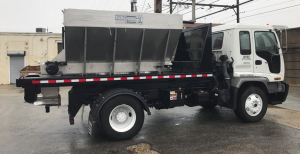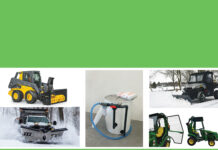By Erich Oelschlegel, ASM![]()
Our company, Suburban Snow Plow, has always been a snow-only family company. My father bought a used Jeep in 1973 that came with a plow. He began plowing on the side; and apparently, the apple hasn’t fallen far from the tree. When we’re not plowing, my siblings and I are telecom project managers, school teachers, web designers, students and stay-at-home moms.

As seasonal workers, we relied on bagged salt, which is the usual starting point for most snow removal companies. As a product upsell, bagged salt is fairly profitable and initial costs are low, especially for servicing residential properties. Tailgate-mounted spreaders are reasonably inexpensive and also provide sufficient capacity to service larger lots, although refilling may be required midway. Bag counting provides an easy way to calculate and monitor salt usage. Storing and handling is a breeze, requiring only a forklift to load, unload and move materials around.
However, there have been growing pains. When we started using brine, the mixer took up half of the garage. When we outgrew the other half, bagged salt pallets had to get stacked against the fence line. In the 2017-2018 season, our property count grew by 50 percent without much growth in available equipment. Routes got noticeably longer and trucks started coming back mid-shift for a second pallet of salt. Nationwide shortages threatened availability, not to mention long lead times from order to delivery. Clearly, bagged salt could only scale so much and would not be able to keep up with demand.

As the business grew into commercial properties and larger lots, bulk salt began to look very appealing. However, this next step required careful thought and consideration in addition to some steep initial costs. A number of hurdles stood in our way. We weren’t able to store large quantities of salt. We needed a dedicated yard to store and handle bulk salt, something that was hard to come by (or cost prohibitive) given our urban customer base. We would also need new equipment.
Bulk salt is a long-term investment. While the price of bulk salt is attractive (at about a third of the cost of bagged), the infrastructure required and other overhead costs are daunting. In fact, some companies may not see an instant return on investment. Here are some things to consider before making the switch.
Storage
Bagged salt on pallets can be stored just about anywhere as long as a forklift can get to it. Stacking pallets effectively doubles your storage density without sacrificing ground area. Plus, its packaging provides weatherization from the elements. A tarp and some bungees are all it takes for additional protection.
Storing bulk salt requires a larger yard accessible to dump trucks and effective containment to shield the product from the elements. Finding good access — at a reasonable price and appropriately zoned — may prove to be the biggest challenge.
SHOULD YOU MAKE THE JUMP?
As snow and ice management companies grow, it makes sense to move away from bagged products to bulk salt. Consider the following if you think you’re ready to make the move.

Material Handling
Adding bulk salt to your operation also means adding heavy equipment. While a forklift is sufficient to move pallets of bagged salt, a bucket loader is a must-have for bulk. Skid steers are good all-around workhorses for the job, but they may take longer to load larger trucks.
Bulk bags can also substitute for bagged at the pallet level if you currently use tailgate spreaders. Loading these is a cinch with a filler stand and a skid steer with bucket attachment. However, you’ll want to make sure your bulk bags and forklift are rated for the weight you’re loading, as it’s easy to overfill.
Smaller form options are also possible, e.g., trash cans, or even five-gallon buckets or sand bags. However, every stage of material handling requires additional labor, and finding that sweet spot is crucial. Specialized bagging machines are available but come with upfront costs. A full transition to bulk may not ever occur, and it may actually make more sense to stick with commercial bagged salt in some cases.
Resupply
Due to the packaging, bagged salt is usually purchased in less than truckload (LTL) quantities. This is great for companies without a large yard but may require a more frequent resupply.
With bulk salt, minimum purchase requirements are a factor. Be prepared to handle large quantities at a time and to keep a clean and well-managed yard. While it’s easy to rearrange pallets of bagged salt after delivery (e.g., from roadside into the yard), bulk should be dumped once. Also, you may be sitting on a large pile of unused salt when the season ends, so keep a watchful eye on your stock levels.

Application
Bagged salt is optimal for low-volume application using gravity-fed walk-behinds and tailgate spreaders. These types typically have lower capacities and smaller diameters than what bulk requires and tend to clog easily.
Bulk is better applied using bulk spreaders, which are typically force-fed via augers or by conveyor. Moreover, their larger capacities enable them to be operated longer before refilling. While bulk spreaders exist for light-duty trucks, a medium-duty truck can carry more salt, with fewer reloadings, resulting in greater efficiency. Cab-over designs are optimal since a short wheelbase allows for a tight turning radius.
Routing
While bagged is still good for diverse routes with smaller properties and residential customers, bulk lends itself better to large commercial lots and roadways. For many of us without municipal contracts, adding a medium-duty truck to an otherwise light-duty fleet presents additional risks. However, a “salt only” route that supplements or even fully replaces salting tasks on other plow routes may be a viable option.
Conclusion
Not long ago, salting a property was an upsell, an added service. Nowadays, it’s a job requirement and plays an integral part in overall operations. Making the switch from bagged to bulk isn’t an easy or inexpensive process; but with some careful planning and execution, it can make a huge difference.
Erich Oelschlegel, ASM, runs a website design consultancy and serves as technology manager at Suburban Snow Plow in Philadelphia. Email him at erich.oelschlegel@suburbansnowplow.com.
This article was featured in the Snow & Ice Management Association’s Snow Business annual Ice Management issue. Read the whole issue here.











![[VIDEO] Dickies®: Discover Workwear That’s Anything But Uniform](https://turfmagazine.com/wp-content/uploads/2023/06/1647663814-4b1a2a7742790a9b1e97a3b963477850192e1d6a9dfba9b07214a77bae25d6e3-d-218x150.jpg)































![[VIDEO] Dickies®: Discover Workwear That’s Anything But Uniform](https://turfmagazine.com/wp-content/uploads/2023/06/1647663814-4b1a2a7742790a9b1e97a3b963477850192e1d6a9dfba9b07214a77bae25d6e3-d-324x160.jpg)